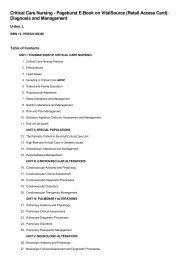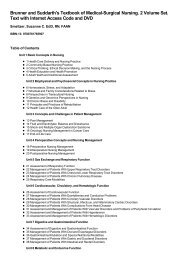Annual Editions: Dying, Death, and Bereavement 12/13 by ...
Annual Editions: Dying, Death, and Bereavement 12/13 by ...
Annual Editions: Dying, Death, and Bereavement 12/13 by ...
Create successful ePaper yourself
Turn your PDF publications into a flip-book with our unique Google optimized e-Paper software.
<strong>Annual</strong> <strong>Editions</strong>: <strong>Dying</strong>, <strong>Death</strong>, <strong>and</strong> <strong>Bereavement</strong> <strong>12</strong>/<strong>13</strong><br />
Dickinson, George E. MD<br />
ISBN-<strong>13</strong>: 9780078051050<br />
Table of Contents<br />
Preliminary Table of Contents<br />
<strong>Annual</strong> <strong>Editions</strong>: <strong>Dying</strong>, <strong>Death</strong> & <strong>Bereavement</strong>, <strong>12</strong>/<strong>13</strong><br />
Preface<br />
Correlation Guide<br />
Topic Guide<br />
Internet References<br />
Unit 1: Issues in <strong>Dying</strong> <strong>and</strong> <strong>Death</strong><br />
1. Grief in the Age of Facebook, Elizabeth Stone, The Chronicle Review, March 5, 2010<br />
Technology gives us a new way to express grief following a death: Facebook.<br />
2. The Proliferation of Postselves in American Civic <strong>and</strong> Popular Cultures, Michael C. Kearl, Mortality, 15<br />
(1), February 2010<br />
Discusses some curious phenomena in popular <strong>and</strong> civic cultures which indicate an increasing presence of the<br />
dead in everyday life.<br />
3. Roadside Memorial Policies in the United States, George E. Dickinson <strong>and</strong> Heath C. Hoffmann, Mortality,<br />
15 (2), May 2010<br />
A survey of the 50 US states regarding roadside memorials revealed that 23 have a policy, yet all tend to be<br />
sensitive to the role which roadside memorials play in expressing survivors' grief <strong>and</strong> try to balance those needs<br />
with any safety hazards that memorials may pose.<br />
4. Brain <strong>Death</strong> Guidelines Vary at Top US Neurological Hospitals, Susan Jeffrey, Medscape Medical News,<br />
2008<br />
A recent survey reveals widespread brain death guidelines in US hospitals.<br />
5. Criteria for a Good <strong>Death</strong>, Edwin Shneidman, Suicide <strong>and</strong> Life-Threatening Behavior, 37 (3), 2007<br />
The late Edwin Shneidman outlines ten criteria for a good death.<br />
Unit 2: <strong>Dying</strong> <strong>and</strong> <strong>Death</strong> across the Life Cycle<br />
6. <strong>Death</strong> in Disney Films: Implications for Children's Underst<strong>and</strong>ing of <strong>Death</strong>, Meredith Cox, Erin Garrett,<br />
<strong>and</strong> James A. Graham, Omega, 50 (4), 2004–2005<br />
Examines the potential influence of Disney films on children's concepts of death, using a content analysis of<br />
Disney animated films.<br />
7. Teaching Children about <strong>Death</strong> <strong>and</strong> Grief, Kirsti A. Dyer, Help a Child Cope with Loss or <strong>Death</strong>,<br />
Suite101.com<br />
Presents teachable moments regarding children <strong>and</strong> death.<br />
8. Helping Military Kids Cope with Traumatic <strong>Death</strong>, Linda Goldman, TAPS, Fall 2008<br />
Practical advice for dealing with children <strong>and</strong> the death of a significant other in the military.<br />
9. Needs of Elderly Patients in Palliative Care, Helle Wijk <strong>and</strong> Agneta Grim<strong>by</strong>, American Journal of Hospice<br />
<strong>and</strong> Palliative Medicine, 29 (2), April/May 2008
A pilot study of elderly patients' end-of-life needs in a Swedish geriatric palliative care unit concluded that<br />
elimination of physical pain was a primary need of the patients.<br />
10. End-of-Life Concerns <strong>and</strong> Care Preferences: Congruence among Terminally Ill Elders <strong>and</strong> their<br />
Family Caregivers, Daniel S. Gardner <strong>and</strong> Betty J. Kramer, Omega, 60 (3), 2009–2010<br />
An examination of end-of-life issues <strong>and</strong> care preferences of terminally ill older persons <strong>and</strong> their caregivers.<br />
Unit 3: The <strong>Dying</strong> Process<br />
11. <strong>Dying</strong> on the Streets: Homeless Persons' Concerns <strong>and</strong> Desires about End-of-Life Care, John Song et<br />
al., Journal of General Internal Medicine: Official Journal of the Society for Research <strong>and</strong> Education in Primary<br />
Care Internal Medicine, 22 (4), April 2007<br />
In-depth interviews with 53 homeless individuals in Minnesota regarding end-of-life care concluded that they worry<br />
about dying <strong>and</strong> end-of-life care.<br />
<strong>12</strong>. <strong>Death</strong> <strong>and</strong> <strong>Dying</strong> across Cultures, Gihan ElGindy, MinorityNurse.com, 2010<br />
Talks about the importance of nurses' being sensitive to unique religious <strong>and</strong> cultural needs of patients with<br />
terminal illnesses.<br />
<strong>13</strong>. Are They Hallucinations or Are They Real? The Spirituality of <strong>Death</strong>bed <strong>and</strong> Near-<strong>Death</strong> Visions, L.<br />
Strafford Betty, Omega, 53 (1–2), 2006<br />
Do the living really see the dead? The author looks into this "twilight zone" to determine if this is real or a mere<br />
hallucination.<br />
14. A Spreading Appreciation for the Benefits of Hospice Care, Kerry Hannon, U.S. News & World Report,<br />
December 15/ December 22, 2008<br />
Discusses types of hospice programs <strong>and</strong> the pros <strong>and</strong> cons of hospice in today's world.<br />
15. When <strong>Death</strong> Strikes without Warning, Jennifer Couzin, Science, 321, July 4, 2008<br />
Presents information about the devastating effect of epilepsy <strong>and</strong> sudden death.<br />
Unit 4: Suicide<br />
16. Self-Harming Behavior <strong>and</strong> Suicidality: Suicide Risk Assessment, Mark J. Goldblatt <strong>and</strong> John T.<br />
Maltsberger, Suicide <strong>and</strong> Life-Threatening Behavior 41 (2), April 2011<br />
A case report is discussed <strong>and</strong> emphasizes the importance of a thorough suicide risk assessment <strong>and</strong> the<br />
importance of considering a broad overview of the patient's presentation.<br />
17. Effects of Race <strong>and</strong> Precipitating Event on Suicide versus Nonsuicide <strong>Death</strong> Classification in a<br />
College Sample, Rheeda L. Walker <strong>and</strong> Kelci C. Flowers, Suicide <strong>and</strong> Life-Threatening Behavior, 41 (1),<br />
February 2011<br />
A sample of 109 black <strong>and</strong> white college students were r<strong>and</strong>omly assigned to read three vignettes involving<br />
premature death <strong>and</strong> to determine what happened, suicide or otherwise.<br />
18. Ethical, Legal, <strong>and</strong> Practical Issues in the Control <strong>and</strong> Regulation of Suicide Promotion <strong>and</strong><br />
Assistance over the Internet, Brian L. Mishara <strong>and</strong> David N. Weisstub, Suicide <strong>and</strong> Life-Threatening Behavior,<br />
37 (1), February 2007<br />
How much control is needed regarding suicide websites? How far can society go in allowing the Internet to help<br />
individuals take their lives via suicide?<br />
19. Why We Need Qualitative Research in Suicidology, Heidi Hjelmel<strong>and</strong> <strong>and</strong> Birthe Loa Knizek, Suicide <strong>and</strong><br />
Life-Threatening Behavior, 40 (1), February 2010<br />
The authors argue that quantitative methodology focuses on explanations, whereas an increased focus on<br />
underst<strong>and</strong>ing through qualitative methodology is needed in research on suicides.<br />
20. A Search for <strong>Death</strong>: How the Internet Is Used as a Suicide Cookbook, Rheana Murray, Chrestomathy, 7,<br />
2008<br />
Through Internet interviews the author examines the role that suicide websites play toward suicides. What<br />
methods are recommended for suicide on these cookbookoriented sites?
Unit 5: Animals <strong>and</strong> <strong>Death</strong><br />
21. Good Mourning, George E. Dickinson, College of Charleston Magazine, 15 (2), spring, 2011<br />
The article discusses the role of a veterinarian in the death of a pet <strong>and</strong> also the seriousness that should be given<br />
<strong>by</strong> everyone to the death of a child's companion animal.<br />
22. When a Cherished Pet Dies, New York-Pres<strong>by</strong>terian, The University Hospitals of Columbia <strong>and</strong> Cornell,<br />
2006<br />
Addresses the death of pets among the elderly <strong>and</strong> how they might react <strong>and</strong> then cope.<br />
23. An Examination of the Potential Role of Pet Ownership, Human Social Support <strong>and</strong> Pet Attachment<br />
in the Psychological Health of Individuals Living Alone, Nikolina M. Duvall Antonacopoulos <strong>and</strong> Timothy A.<br />
Pychyl, Anthrozoos, 23 (1), 2010<br />
Pet ownership, emotional attachment, <strong>and</strong> human social support were examined to predict scores on<br />
measures of loneliness <strong>and</strong> depression.<br />
24. Veterinary Hospice: Ways to Nurture Our Pets at the End of Life, Amy Souza, Best Friends Magazine,<br />
July/August 2009<br />
Not only are hospice programs developing for humans, but these programs are also cropping up for pets, though<br />
somewhat sparingly, around the United States.<br />
Unit 6: Ethical Issues of <strong>Dying</strong> <strong>and</strong> <strong>Death</strong><br />
25. What Living Wills Won't Do, Eric Cohen, The Weekly St<strong>and</strong>ard, April 18, 2005<br />
Also inspired <strong>by</strong> the Terri Schiavo case, this article discusses the limitations of living wills <strong>and</strong> durable powers of<br />
attorney for health care.<br />
26. When Students Kill Themselves, Colleges May Get the Blame, Ann H. Franke, The Chronicle of Higher<br />
Education, June 24, 2004<br />
Suicide among college students has always been a nightmare for parents; now it has become a risk management<br />
issue for college administrators <strong>and</strong> professors. This article addresses the issue of responsibility for suicides<br />
among college students <strong>and</strong> how <strong>and</strong> when students are at risk.<br />
27. Cannabis Use in Long-Term Care: An Emerging Issue for Nurses, Roxanne Nelson, American Journal<br />
of Nursing, April 2011<br />
When dealing with patients in end-of-life care <strong>and</strong> marijuana, many nurses protocol is "don't ask, don't tell.".<br />
28. Ethics <strong>and</strong> Life's Ending, Robert D. Orr <strong>and</strong> Gilbert Meilaender, First Things, August/September 2004<br />
This article provides a point-counterpoint discussion of the quality of life arguments for passive euthanasia <strong>and</strong> the<br />
right to die. Knowledge from both points of view challenge the student who is attempting to formulate an<br />
underst<strong>and</strong>ing of the complex issues surrounding this controversy.<br />
29. I Was a Doctor Accustomed to <strong>Death</strong>, But Not His, Marc Agronin, Salon, Saturday, Feb 5, 2011<br />
Medical doctor son tells his story of dealing with his own father as patient. It was the best lesson in caring for the<br />
dying.<br />
Unit 7: Funerals<br />
30. The Contemporary American Funeral, Michael R. Leming <strong>and</strong> George E. Dickinson, Underst<strong>and</strong>ing <strong>Dying</strong>,<br />
<strong>Death</strong>, <strong>and</strong> <strong>Bereavement</strong>, Wadsworth-Cengage, 2011<br />
This article provides an overview of the present practice of funeralization in American society, including the<br />
traditional <strong>and</strong> alternative funeral arrangements. The functions of funerals relative to the sociological, psychological,<br />
<strong>and</strong> theological needs of adults <strong>and</strong> children are also discussed.<br />
31. How Different Religions Pay Their Final Respects, William J. Whalen, U. S. Catholic, September 1990<br />
This article discusses the way in which obituaries announce to the world that someone has died. Actually many do<br />
not die, they "suddenly" or "peacefully" or "courageously" or "quietly" or "unexpectedly" disappear.
32. Building My Father's Coffin, John Manchester, Salon.com, Friday, Jun 4, 2010<br />
"My body is to be placed in a plain pine box. I would like my children to make the box." William Manchester knows<br />
that grief work is best when done as a family.<br />
33. Dealing with the Dead, Jennifer Egan, The New Yorker, October 11, 2010<br />
It is possible to facilitate our grieving <strong>by</strong> remembering dead relatives <strong>by</strong> wearing clothes <strong>and</strong> jewelry that once<br />
belonged to them to their funerals. www.newyorker.com/reporting/2010/10/11/101011fa_fact_egan?<br />
printable=true#ixzz1McGXIeRw<br />
Unit 8: <strong>Bereavement</strong><br />
34. The Grieving Process, Michael R. Leming <strong>and</strong> George E. Dickinson, Underst<strong>and</strong>ing <strong>Dying</strong>, <strong>Death</strong>, <strong>and</strong><br />
<strong>Bereavement</strong>, Wadsworth-Cengage, 2011<br />
This article discusses the seven basic coping strategies related to the bereavement process (shock <strong>and</strong> denial,<br />
disorganization, volatile emotions, guilt, loss <strong>and</strong> loneliness, relief, <strong>and</strong> reestablishment) <strong>and</strong> the four tasks of<br />
bereavement (accepting the reality of the loss, experiencing the pain of grief, adjusting to an environment in which<br />
the deceased is missing, <strong>and</strong> the withdrawing of emotional energy <strong>and</strong> reinvesting it in other relationships).<br />
35. Disenfranchised Grief, Kenneth J. Doka, Disenfranchised Grief: Recognizing Hidden Sorrow, Lexington<br />
Books, 1989<br />
Kenneth Doka discusses the unique situation of bereaved survivors whose loss is not, or cannot be, openly<br />
acknowledged, publicly mourned, or socially supported.<br />
36. Challenging the Paradigm: New Underst<strong>and</strong>ings of Grief, Kenneth J. Doka, 2007<br />
Kenneth Doka describes five significant ways in which earlier underst<strong>and</strong>ings or paradigms of grief have been<br />
challenged. He also discusses three current challenges to the field of thanatology <strong>and</strong> two others that are likely to<br />
occur in the not-too-distant future.<br />
37. Enhancing the Concept of Disenfranchised Grief, Charles A. Corr, Omega, vol. 38, no. 1, 1998/1999<br />
This article enhances <strong>and</strong> broadens the concept of disenfranchised grief in signifi cant ways as it indicates that<br />
there are aspects of most losses that are indeed disenfranchised.<br />
38. We've Been Misled about How to Grieve, Nicholas Kohler, Maclean's Magazine, February 21, 2011<br />
This article discusses much of the misinformation most people assume about grieving.<br />
39. The Increasing Prevalence of Complicated Mourning, Therese A. R<strong>and</strong>o, Omega,<br />
This article operationalizes complicated mourning <strong>and</strong> identifies its seven high-risk factors. The author argues that<br />
the prevalence of complicated mourning is increasing today due to a number of contemporary sociocultural <strong>and</strong><br />
technological trends, with problems in both the mental health profession <strong>and</strong> the field of thanatology that are<br />
preventing or interfering with requisite treatment. New treatment policies <strong>and</strong> models are now m<strong>and</strong>ated for<br />
intervention in complicated mourning.<br />
40. Rituals of Unburdening, Mark Mercurio, Hastings Report, March/April 2008<br />
This article provides an underst<strong>and</strong>ing of the special issues related to the care of parents who have lost at child in<br />
neonatal death.<br />
41. 11 Ways to Comfort Someone Who's Grieving, Harvard Medical School,HealthBeat, August 24, 2010,<br />
www.health.harvard.edu/router_ci.php/healthbeat/11-ways-to-comfort-someone-who%E2%80%99s-grieving<br />
If you find yourself tongue-tied or uncertain of what to do in the face of someone's loss, here are some steps you<br />
might try.<br />
Test-Your-Knowledge Form<br />
Article Rating Form
















